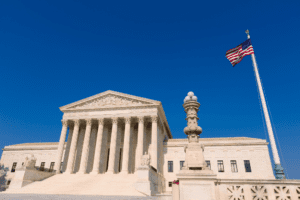 The dissent continued: There is, of course, another side to the story. I am not simply saying that “guns are bad.” See ante, at 8 (ALITO, J., concurring). Some Americans use guns for legitimate purposes, such as sport (e.g., hunting or target shooting), certain types of employment (e.g., as a private security guard), or self-defense. Cf. ante, at 4–6 (ALITO, J., concurring). Balancing these lawful uses against the dangers of firearms is primarily the responsibility of elected bodies, such as legislatures. It requires consideration of facts, statistics, expert opinions, predictive judgments, relevant values, and a host of other circumstances, which together make decisions about how, when, and where to regulate guns more appropriately. That consideration counsels modesty and restraint on the part of judges when they interpret and apply the Second Amendment. Consider, for one thing, that different types of firearms may pose different risks and serve different purposes. The Court has previously observed that handguns, the type of firearm at issue here, “are the most popular weapon chosen by Americans for self-defense in the home.” District of Columbia v. Heller, 554 U. S. 570, 629 (2008). But handguns are also the most popular weapon chosen by perpetrators of violent crimes. In 2018, 64.4% of firearm homicides and 91.8% of nonfatal firearm assaults were committed with a handgun. Dept. of Justice, Bureau of Justice Statistics, G. Kena & J. Truman, Trends and Patterns in Firearm Violence, 1993–2018, pp. 5–6 (Apr. 2022).
The dissent continued: There is, of course, another side to the story. I am not simply saying that “guns are bad.” See ante, at 8 (ALITO, J., concurring). Some Americans use guns for legitimate purposes, such as sport (e.g., hunting or target shooting), certain types of employment (e.g., as a private security guard), or self-defense. Cf. ante, at 4–6 (ALITO, J., concurring). Balancing these lawful uses against the dangers of firearms is primarily the responsibility of elected bodies, such as legislatures. It requires consideration of facts, statistics, expert opinions, predictive judgments, relevant values, and a host of other circumstances, which together make decisions about how, when, and where to regulate guns more appropriately. That consideration counsels modesty and restraint on the part of judges when they interpret and apply the Second Amendment. Consider, for one thing, that different types of firearms may pose different risks and serve different purposes. The Court has previously observed that handguns, the type of firearm at issue here, “are the most popular weapon chosen by Americans for self-defense in the home.” District of Columbia v. Heller, 554 U. S. 570, 629 (2008). But handguns are also the most popular weapon chosen by perpetrators of violent crimes. In 2018, 64.4% of firearm homicides and 91.8% of nonfatal firearm assaults were committed with a handgun. Dept. of Justice, Bureau of Justice Statistics, G. Kena & J. Truman, Trends and Patterns in Firearm Violence, 1993–2018, pp. 5–6 (Apr. 2022).
Handguns are also the most commonly stolen type of firearm—63% of burglaries resulting in gun theft between 2005 and 2010 involved the theft of at least one handgun. Dept. of Justice, Bureau of Justice Statistics, L. Langton, Firearms Stolen During Household Burglaries and Other Property Crimes, 2005– 2010, p. 3 (Nov. 2012). Or consider, for another thing, that the dangers and benefits posed by firearms may differ between urban and rural areas. See generally Brief for City of Chicago et al. as Amici Curiae (detailing particular concerns about gun violence in large cities).
Here, the dissent is alluding to principles of federalism. The overall idea is that we have different values and dynamics among the 50 states and those states should be the testing grounds for policies that can be adopted or rejected at the national level. It is usually the more conservative justices that adopt principles of federalism while the more liberal justices prefer a strong, central government. Here, that dynamic is flipped with three of the most “liberal” justice dissenting from the opinion that extended Second Amendment rights on a national level.
